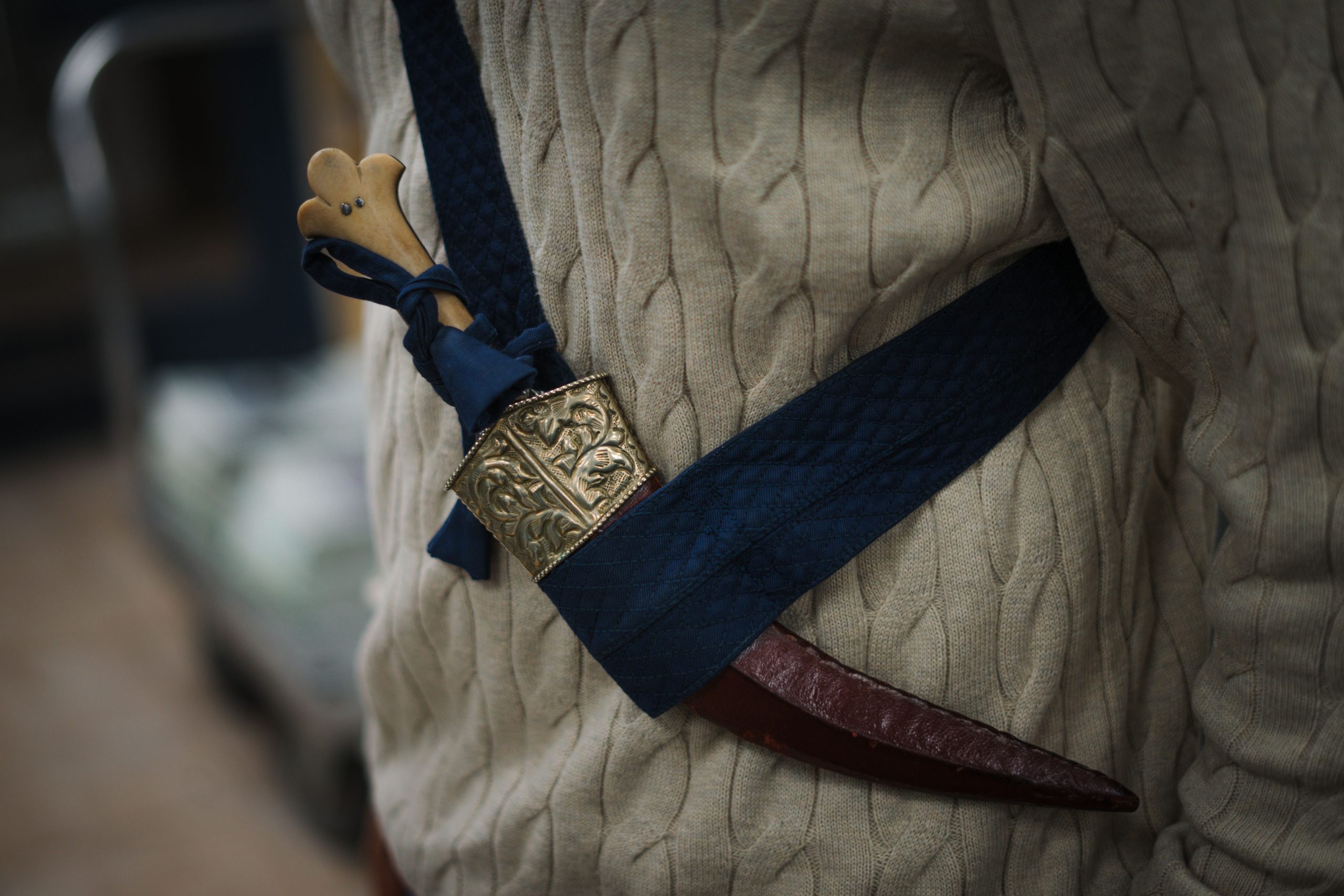Students at the U of M are calling for greater awareness on campus around the Kirpan — a blade that resembles a dagger or sword that is constantly worn as part of the Khalsa Sikh religion.
Isham Singh, Jasvir Kaur, Gurnoor Singh, Gurkaranbir Singh, Devkarn Singh and Manvir Kaur are executive members of the University of Manitoba Sikh Students’ Association (UMSikhSA) and state that incidents on campus have made it clear that many students lack understanding about the Kirpan — and they would like the university to help with an education initiative.
Devkarn Singh explained that during one of his 2024 summer term final exams, he was pulled out of the exam room by a campus peace officer following concerns from one of the students over his Kirpan. “[The peace officer] said that one of the students complained that he was wearing a knife. He was basically telling me to conceal it,” said Devkarn Singh.
The officer recommended that he hide the Kirpan, “so that the students can continue their exam without being scared,” according to Singh. In the end, he did not hide it, but acknowledged that the officer was understanding of the situation.
Another incident occurred on Nov. 4 during the Celebrating Oneness event in the multi-purpose room of UMSU University Centre. The event was jointly organized by the UMSikhSA along with other faith groups on campus and focused on educating different communities on religious rituals and cultures. A three-foot Kirpan was present on a table to raise awareness.
“[Campus officers] were like, ‘just hide the bigger Kirpan, because we don’t want to create trouble,’” said Devkarn Singh. “They were worried that the students would take the Kirpan and try to harm someone.
“If the university and security do not want to raise awareness about [the Kirpan], the least they can do is not stop us while doing it, right?”
Gurkaranbir Singh stated that at the request of Security Services, the Kirpan was placed away out of public sight “because we did not want that to jeopardize the rest of the event.”
In a statement from Security Services, they indicated that security previously met with an organizer and declined the request for a three-foot Kirpan at the event following discussions “for general safety reasons.”
“Security was informed on Nov. 4 that a three-foot Kirpan sword was at the event. The organizer was contacted on site and reminded of the meeting and decisions prior to the event. Organizers were directed to remove the sword from campus and do so in [a] manner where the sword was not visible. It is our understanding it was removed.”
Executive members of UMSikhSA stated that Security Services never reached out to the association directly, but spoke through organizers of other groups of the joint event. “The only thing we were informed through that person was that there was a suggestion that you’re not allowed to wear the three-foot Kirpan,” they wrote in a joint statement. “We followed this suggestion and only displayed it securely and took all the precautions with two members at the display the entire time.”

The significance of the Kirpan
The Kirpan is a religious sword which is to be worn at all times by a baptized Sikh — meaning a Sikh who has undergone the Amrit Sanchar initiation ceremony. An individual may be baptized at any age, but must be willing to do so on their own will.
The word Kirpan is derived from two Punjabi words, “kirpa” meaning mercy, and “aan,” meaning honour and self-respect.
Baptized Sikhs must commit to the code of conduct of the Khalsa, a Sikh order created in 1699 by the 10th Sikh guru — a term used to define a spiritual master. The Khalsa was established as a group of warrior Sikhs to defend any victims of aggression or injustice.
The Khalsa entails wearing the “five Ks” at all times: Kara (a steel bracelet), Kes (uncut hair), Kanga (a small wooden comb), Kachhera (cotton undershorts) and the Kirpan. “We cannot remove them at any cost,” said Gurnoor Singh.
Khalsa Sikhs must be Tyar-Bar-Tyar, stated Gurkaranbir Singh, “which means you have to be ready at all times for any situation that comes to you. You need to be able to handle and fight back and tackle the situation.”
The Kirpan is worn in a sheath on a strap or a belt and must be made of iron.
“It’s a manifestation of the energy of God,” said Manvir Kaur. “The energy of God is the energy to create or destroy, that’s how we are all alive. In our faith, we believe that God is the one who creates the world and God is the one who ends the world. So same with the Kirpan, the Kirpan has the power to save somebody’s life, but […] it can also take somebody’s life.
“The Kirpan holds that power that when injustice arises and there’s no other way to get justice it can save someone’s life,” explained Kaur. “As Sikhs, it’s our responsibility to uphold righteous duty.”
Gurkaranbir Singh stated that originally, the Kirpan was typically three feet long. The length of the blade was eventually reduced due to British colonial policies and laws and can now vary considerably.
In Canada, Kirpans are permitted with blades of 6 cm or less on domestic or international flights — excluding the United States. Longer blades should be packed in checked luggage, according to the Canadian Air Transport Security Authority.
“Just like in the Canadian Parliament, the mace, which is used for a ceremonial use and holds its own special meaning, the Sikhs have the Kirpan which holds its own special meaning as well,” said Gurkaranbir Singh.

Kirpans allowed on campus, no specific university policy
Kirpans can legally be worn in most public places in Canada, including on campuses — according to a 2006 ruling from the Supreme Court of Canada.
In an email thread obtained by the Manitoban from Christopher Bohonis, assistant director of Security Services, Bohonis acknowledged that “it does not appear that the university has specific policy pertaining to Kirpans.” This was later confirmed in a statement from the university’s administration.
“Without a policy, this is what we have been following/recommending generally,” wrote Bohonis, followed by several conditions.
The conditions listed by Bohonis include that the wearer must be a Khalsa Sikh or that it is part of their religious beliefs, that they may be required to provide a letter from the gurdwara — a Sikh place of worship — confirming that they are Khalsa and that the Kirpan is not to be worn visibly, but under the wearer’s clothing.
Other conditions listed include “the Kirpan must be sufficiently secured to render removal difficult, but not impossible” and that the Kirpan should not exceed 17.8 cm in length, while “smaller Kirpans are preferable.”
“Within our policies, including RWLE (Respectful Work and Learning Environment), members of the UM community, including every student and employee, are entitled to a respectful work and learning environment, free from discrimination and we provide for reasonable accommodation,” stated the university’s administration.
“Should a situation develop where the visibility of a Kirpan, its overall size or an allegation of misuse is made, the matter would be addressed in a private and sensitive manner. To date we have not encountered a situation of misuse.”
Bohonis also noted that the university has not encountered a situation where the Kirpan was misused, but stated that Security Services has “attended a few calls respecting Kirpans in the past.”
Manvir Kaur hopes that if the university does adopt a policy specific to Kirpans in the future, that at least five baptized Sikhs are present when the policy is being created. Kaur indicated that during her Amrit Sanchar, they told her to never conceal the Kirpan which goes against the procedure that the university is following.
“These guidelines do not align with the Rehat Maryada — which is the code of conduct that all Sikhs follow,” said Gurkaranbir Singh.
Calls for more Kirpan awareness on campus
Devkarn Singh said that he would like others to know what is a Kirpan, why it is worn and that it is completely legal. “I think that is the very least that I want all students to know […] or even professors.”
“If one of us is walking and our Kirpan is visible, and then someone reports it to security, they are going to come running and they might even call the police,” said Jasvir Kaur, citing a lack of awareness on the religious item. “It just blows my mind that our institutions are so behind, whereas in terms of research and other things, they are keeping up and leading but not in this case.”
Isham Singh mentioned that he and other baptist Sikhs are ready to host workshops, lectures or whatever the university needs to educate others on campus, but stated that “we can only do so much with the limited resources.”
“It’s more so about sustainability. Yes, we are all here doing this work, but once we graduate, who is going to take over?” he added.
The UMSikhSA has been trying to raise awareness through videos and events, but Isham Singh acknowledged that the students’ association is low on funding.
“There’s been many times where some of our people just put in money from our own pockets because we don’t want to use up the fund,” said Manvir Kaur.
“We’ve talked to a lot of different people in positions of authority and we’ve sent a lot of emails, but have yet to receive a response from most recipients,” said Isham Singh. “We hoped there was an easier way to reach out.”
Despite this, Singh indicated that there are university personnel helping UMSikhSA with educational outreach, naming Edgar French, university coordinator of the Spiritual Care and Multi-Faith Centre (SCMC) and vice-provost (equity) Tina Chen.
Isham Singh said that he would also like to see a religious representative position added to the University of Manitoba Students’ Union board of directors that works directly with the SCMC on campus. “The representative doesn’t have to be Sikh but they should follow their own religion to the highest standard,” said Singh.
“If anyone has any questions, they can just come to us without any fear and we can answer all questions they have in their mind,” said Gurkaranbir Singh.
The University of Manitoba Sikh Students’ Association can be reached at umsikhsa@gmail.com or by Instagram at @umsikhsa.





